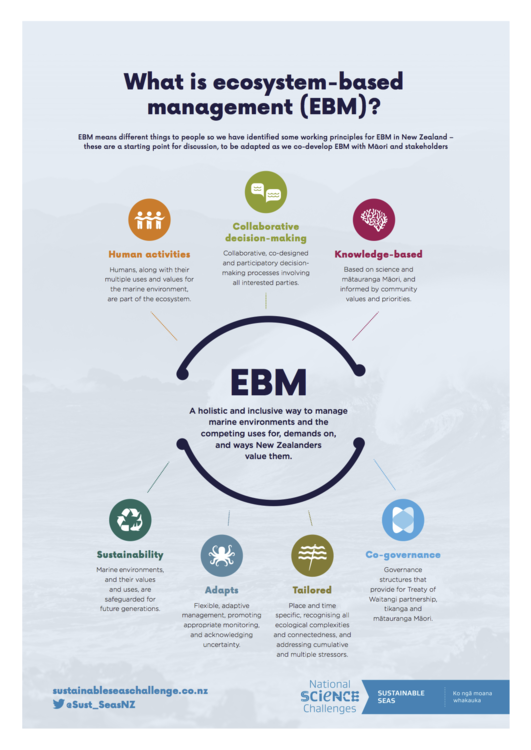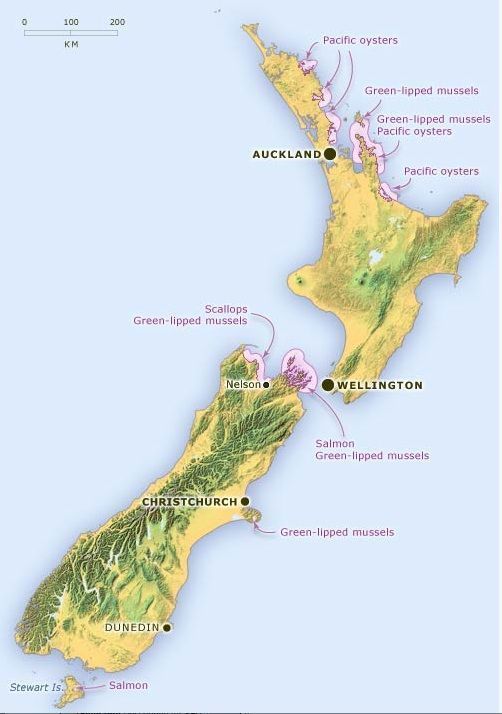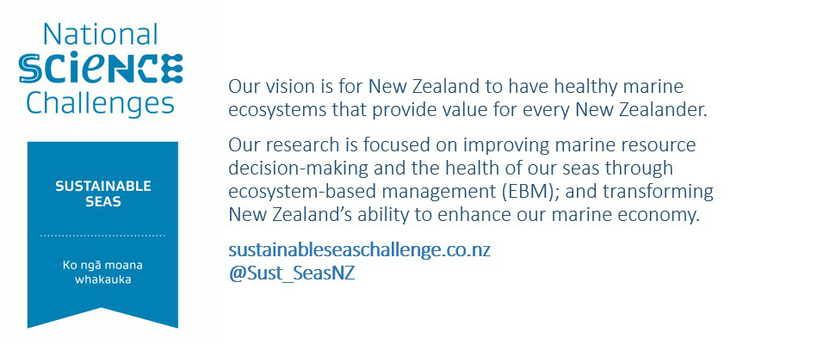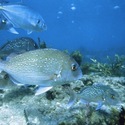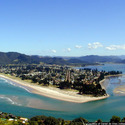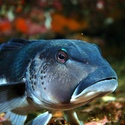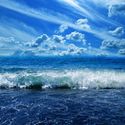The Sustainable Seas National Science Challenge’s vision is for New Zealand to have healthy marine ecosystems1 providing value for every New Zealander. It has seven research programmes, and each programme supports the development of a new way to manage our marine environment called ecosystem-based management2 (EBM).
The Sustainable Seas Challenge’s working definition of EBM3 is: “a holistic4 and inclusive way to manage our marine environments and the competing uses for, demands on, and ways New Zealanders value them”. This definition may change as it co-develops EBM with Māori and stakeholders.
EBM – an explanation
EBM, as a management approach, is an innovative way to manage marine systems. Because EBM is holistic and inclusive it is not a one-size-fits-all framework. The Sustainable Seas Challenge is developing EMB for Aotearoa5 (which has a 4 million square kilometre exclusive economic zone6), but the way EBM is applied will vary to suit local requirements.
The EBM approach has several characteristics.
EBM recognises the many interactions that occur within an ecosystem7 – including humans – rather than looking at single species8 or issues in isolation. This differs to other approaches that are interested in protecting an individual species or dealing with a single activity at a time – sometimes at the expense of other species or activities. EBM acknowledges that trade-offs often form part of the framework.
EBM recognises the value of co-operation. Coastal areas are often used by competing sectors – for recreational or commercial fishing, energy exploration or as wildlife sanctuaries. EBM encourages sectors to work together.
International case studies have shown that successful EBM recognises the importance of and incorporates indigenous9 knowledge. To be successful, EBM for Aotearoa must be founded on mātauranga Māori10 as well as science.
EBM and the Sustainable Seas Challenge
The demands on and uses of New Zealand’s marine resources are increasing, so we need to manage our marine environments differently than we have in the past. Using EBM supports wide consultation and working side by side with Māori and stakeholders (government, business, community and environmental groups and others) and researchers.
Even though Sustainable Seas is a National Science Challenge, researchers of all types are involved, including social scientists11, economists and mātauranga12, legal and policy experts. For EBM to be successful, the Challenge needs to:
- be aware of what collaborative decision-making looks like and how to make it work
- identify important institutional, social and cultural factors regarding marine resources
- assess both the economic and non-monetary values of the marine environment
- investigate how to foster and build trust in science and among the diverse people who work with Sustainable13 Seas.
The Challenge’s biophysical research is focusing on:
- marine ecosystems – how they work and services they provide
- how ecosystems are connected and how they respond to change
- stressors within ecosystems that can lead to tipping points and rapid changes.
Sustainable Seas is developing a number of tools to support EBM. One tool is different types of models, including an extremely detailed ecosystem model of Tasman and Golden Bays. These models enable people to explore ‘what if?’ scenarios, possible outcomes of management decisions, trade-offs and more. And yes, there will be online and mobile apps for groups to use!
EBM and Vision Mātauranga
Each of the 11 National Science Challenges is underpinned by Vision Mātauranga. The goal is to “unlock the innovation14 potential of Māori knowledge, resources and people to assist New Zealanders to create a better future”. EBM complements or aligns well with some important Māori concepts, such as kaitiakitanga15. Appropriately incorporating mātauranga Māori is essential to the successful development of EBM for Aotearoa. The Sustainable Seas Challenge is studying international examples of incorporating indigenous knowledge into resource management16 to help inform EBM for New Zealand.
Developing EBM
The Sustainable Seas Challenge has some big numbers: 222 researchers from 36 organisations working on 40 projects (as of 20 November 2018). It’s rather like an enormous jigsaw puzzle – and all of the pieces fit together in EBM. The researchers are working with other interested parties to create a knowledge base to build and support an EBM framework for New Zealand and develop practical EBM tools that will help marine resource managers to make better decisions.
The team is using Tasman and Golden Bays at the top of the South Island as a case study. Some of the projects explore marine ecosystem services17, ways to protect aquaculture18 from ocean acidification19 and methods to better predict contamination20 risks to kaimoana21, aquaculture and beaches. Other projects look at ways to enhance collaboration22 between Māori, communities, government and industry – keeping in mind the important role of kaitiakitanga/guardianship.
An ambitious task
Sustainable Seas Challenge and EBM – it’s an ambitious task involving biophysical science23, economics, mātauranga Māori, social science, law and policy. It is bringing together groups who haven’t always seen eye to eye, but that is part of the plan. Having everyone working together is essential to develop EBM that is fit for purpose in New Zealand.
Most importantly, the end result needs to be useful and practical – that’s what makes it a challenge!
Nature of science
The ‘Participating and contributing’ strand of the nature of science24 is about students using their science understanding to contribute to their own lives and to society. EBM is a good example of this aspect of NOS in action. Sustainable Seas is consulting with Māori and stakeholders from numerous organisations. Ideally, participants will use the EBM knowledge and tools to help inform their discussions, and ultimately, resource managers will use them to make decisions about how to manage our marine resources.
National Science Challenges update
Activity idea
The student activity Environmental thinking and planning with ecosystem-based management (EBM) uses EBM components to consider how a local area of significance could be managed, or it can form the basis for planning a local environmental project.
Sustainable Seas collection
See the range of content that we have developed using resources from the Sustainable Seas National Science Challenge in this handy collection. Learn how to create, use and share collections here.
Useful links
The US National Oceanic and Atmospheric Administration website explains EBM as an integrated management approach.
Visit the Sustainable Seas Challenge website to learn more about how it is developing and using EBM.
The Sustainable Seas Challenge has created a set of cards that introduce key elements of kaitiakitanga. The 11 Hui-te-ana-nui: Kaitiakitanga cards are available to download here. If you would like hard copies of the cards please contact sustainableseasNC@niwa.co.nz. Sustainable Seas notes that the content included in the summaries remain under the guardianship of the original knowledge sources.
Acknowledgement
This article has been developed using resources from the Sustainable Seas National Science Challenge.
- ecosystem: An interacting system including the biological, physical, and chemical relationships between a community of organisms and the environment they live in.
- ecosystem-based management: An integrated management approach that recognises the full array of interactions within an ecosystem, including humans.
- ecosystem-based management: An integrated management approach that recognises the full array of interactions within an ecosystem, including humans.
- holistic: Emphasising the importance of the whole and the interdependence of its parts, looking at the entire system. In healthcare, this means looking at all aspects of a patient's well-being and not just treating a particular pain or disease.
- Aotearoa: The Māori name for New Zealand, meaning Land of the Long White Cloud.
- exclusive economic zone (EEZ): A seazone prescribed by the United Nations Convention on the Law of the Sea over which a country has special rights concerning the exploration and use of marine resources. It extends 200 nautical miles (370 kilometres) from the coast.
- ecosystem: An interacting system including the biological, physical, and chemical relationships between a community of organisms and the environment they live in.
- species: (Abbreviation sp. or spp.) A division used in the Linnean system of classification or taxonomy. A group of living organisms that can interbreed to produce viable offspring.
- indigenous: Originating and living or occurring naturally in an area or environment. People who are the original inhabitants of an area, or their descendants.
- mātauranga Māori: A contemporary term referring to Māori knowledge, Māori ways of knowing and associated practice.
- social scientist: A person who studies societies and relationships of members within societies in order to understand human behaviour.
- mātauranga: Māori cultural knowledge and understanding of the world; Māori wisdom.
- sustainable: A way of using natural products so they are available for future generations.
- Innovation: The development of a new process or product that is then used by others.
- kaitiakitanga: A Māori term that encompasses ideas about care and guardianship of the sea, sky and land – the environment. Kaitiaki refers to those who carry out kaitiakitanga such as tangata whenua (people of the land).
- resource management: Managing human impact on the environment in a way that is sustainable.
- ecosystem services: The benefits ecosystems provide for the environment and people. These include services such as nutrient cycling, flood control, provision of food and water and aesthetic and cultural experiences.
- aquaculture: The farming of aquatic organisms such as fish, crustaceans, molluscs and aquatic plants.
- ocean acidification: Decrease in ocean pH due to higher levels of dissolved carbon dioxide.
- contamination: The introduction of contaminants into a substance.
- kaimoana: Māori word for seafood.
- collaboration: Working together with a common purpose.
- biophysics: The branch of biology that applies the methods of physics to the study of biological structures and processes.
- nature of science: The Nature of Science (NoS), is an overarching and unifying strand of the New Zealand science curriculum. Through it, students develop the skills, attitudes and values to build a foundation for understanding the world around them – understanding how science works in order to make links between scientific knowledge and everyday decisions and actions.
